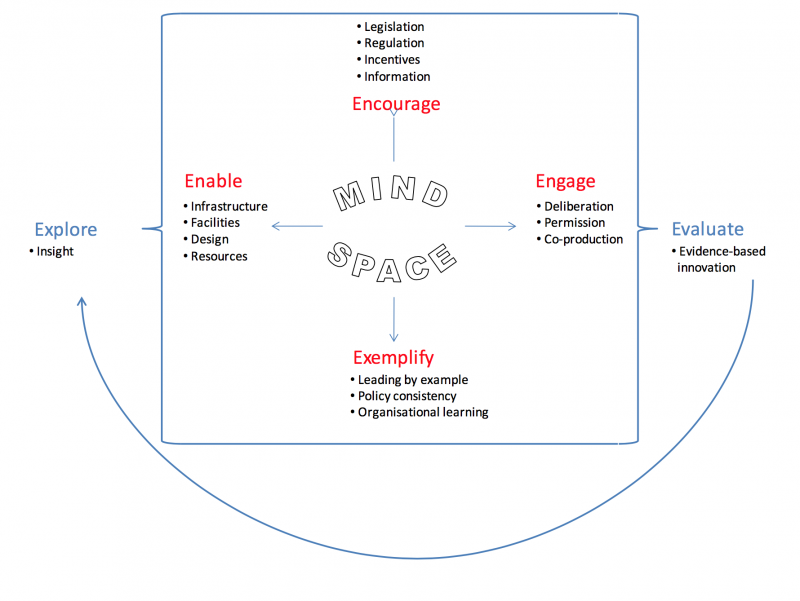Cracking Open the Implications Behind Behavioral Design
Posted on December 6, 2017My first encounter with the topic of behavioral design occurred when I picked up Richard Thaler’s and Cass Sunstein’s seminal book, Nudge, back in 2011. The book aims to explain how cognitive biases and heuristics imperceptibly reinforce certain behaviors and how design and policy could reframe contexts to encourage “favorable” decision making in a way that is described as social engineering through choice architecture. [1] Thaler and Sunstein argue for this practice through the rejection of the classic “homo economicus” concept, which regards individuals as “rational and self-interested actors regardless of situation or context.” Subsequently, individuals subject to nudged behavior through design are prompted to make certain choices without always giving conscious consideration of their actions.
In learning about the ideology behind speculative design, within the context of Anthony Dunne and Fiona Raby’s Speculative Everything, I have been introduced to a contrary argument about how design can be used to incite behavioral change by raising individual awareness through encouraged speculative thought.
“We believe that our behavior does need to change, but it should be up to either individuals to make changes in their behavior (for example, in health and exercise) or the government to ban some kinds of behavior (such as smoking, which effects everyone, not just the smoker). At both extremes the rationale for change is explicit. Design can play a role in highlighting what might happen if behavior does not change, what can be achieved if it does, or simply communicating what needs to change and how. Of course this is an idealistic view of human nature that does not allow for poor education or other factors, but we prefer to base our design approach on this ideal rather than assume people have little or no control over the choices they make. We view people as free agents, not necessarily rational, but free to make up their own minds. As consumers we can choose not to buy products produced by companies or countries whose values we disagree with; as citizens we can vote, demonstrate, protest, and in extreme cases, riot.” [2]
While I agree with Dunne and Raby’s criticism against persuasive design interventions that provoke a form of non-reflective change in user behavior, I question speculative design’s scalable application outside of an academic context and culture. How might we harness aspects of speculative practice and theory to encourage deeper reflection of individual values within existing social frameworks? Where might areas for applied speculative design intervention exist in practice and industry-based settings?
Although the usual motives behind behavioral design in a “nudged” context are to encourage positive behaviors that are likely favorable by most users, a greater point of concern must be raised – who deserves to have that influential power? Similarly, a common argument for participatory co-design is to acknowledge the power that designers wield and to transfer some of that power to the user or client in collaborative design and decision making. While a potential counterargument for design nudging might claim that its influence on behavior also respects freedom of choice through opt-out alternatives (e.g. automatic donor registration), I believe these small-scale interventions are not enough to invoke intentional reflection and reasoning behind individual action.
A report by the Institute for Government Think Tank has laid out two top-down influential models and a framework of factors influencing behavioral change.
“The first is based on influencing what people consciously think about. We might call this the ‘rational’ or ‘cognitive’ model. Most traditional interventions in public policy follow this model. The presumption is that citizens and consumers will analyse the various pieces of information from politicians, governments and markets, the numerous incentives offered to us and act in their best interests (however they define their best interests, or – more paternalistically – however policymakers define them).
The contrasting model of shaping behaviour focuses on the more automatic processes of judgment and influence. This shifts the focus of attention away from facts and information, and towards altering the context within which people act. We might call this the ‘context’ model of behaviour change. The context model recognises that people are sometimes seemingly irrational and inconsistent in their choices, often because they are influenced by surrounding factors. Therefore, it focuses more on ‘changing behaviour without changing minds’.” [3]

Figure from “MINDSPACE: Influencing behavior through public policy”
Though the article renders a comprehensive diagram of conscious vs. unconscious methods of influencing behavioral decision making within a parliamentary context, it still fails to recognize a potential design confluence between the individual, as an intentional agent, and government. Through such methods of change, the government is setting the conditions rather than asking individuals to think about, inform, or decide these conditions themselves (and in that sense is this model truly democratic?)
As we live in a world that encourages increasingly consumptive behavior (e.g. diverted attention, purchase of luxuries/goods, media overload, etc.), it is understandable to see why fields such as behavioral economics and behavioral design have causally emerged. However, in acknowledging this causal relationship, shouldn’t this be a sign that surfacing awareness and probing greater reflection around consumer behavior and attitudes are becoming increasingly necessary for all individuals?
(To be continued, with more specific examples)
[1] Thaler, Richard H., and Cass R. Sunstein. 2009. Nudge: improving decisions about health, wealth, and happiness.
[2] Dunne, Anthony, and Fiona Raby. Speculative Everything: Design, Fiction, and Social Dreaming. MIT Press, 2013. http://www.jstor.org/stable/j.ctt9qf7j7.
[3] Dolan, Paul, Michael Hallsworth, David Halpern, Dominic King, and Ivo Vlaev. “MINDSPACE: Influencing behavior through public policy.” Institute for Government. 2010
– J Liu